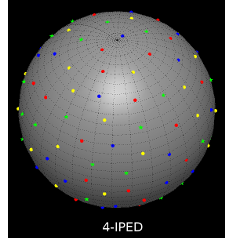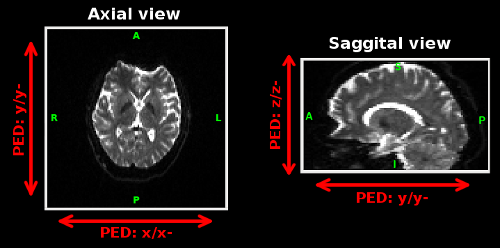|
Size: 4797
Comment:
|
Size: 6902
Comment:
|
| Deletions are marked like this. | Additions are marked like this. |
| Line 18: | Line 18: |
| * The inhomogeneity in main magnetic field should be same across all diffusion weighted images ''i.e.'' all the diffusion images must be acquired with same shim settings. * The field of view, voxel resolution and image matrix size should be consistent across all images. |
* The inhomogeneity in main magnetic field (B0) should be same across all diffusion weighted images ''i.e.'' all the diffusion images must be acquired with same shim settings. * The field of view, voxel resolution, image matrix size, number of slices and slice thickness should be consistent across all images. |
| Line 21: | Line 21: |
| <<BR>> Further, take note about following to enable accurate distortion correction with IPED method with this implementation: |
|
| Line 22: | Line 24: |
| Further, * >= 20 encoding. Larger the better * Even distribution of points * Good interlacing of PEDs * |
* It is recommended to use more than 20 unique diffusion encoding directions. Larger number of diffusion encoding direction would enable better correction. * The diffusion encoding directions should be evenly distributed on the sphere (or one hemisphere). * The diffusion encoding directions for each PEDs should be evenly interlaced ''i.e.'' encoding directions should be evenly distributed for each unique PED as well as for intersection of all PEDs. * In case of multi-shell acquisition, the above recommendation applies to each shell. * This implementation also works with reversed-gradient ([[http://dx.doi.org/10.1109/42.158935|Chang and Fitzpatrick, 1992]]) and its generalized acquisition schemes. Also see {{{user_opts}}} below for more options. |
| Line 36: | Line 37: |
| * IPED_config_filename * fieldmap_filename * echo_spacing * output_base |
* {{{IPED_config_filename}}} is a string specifying the file-name of the IPED-config file. See below for more details about format of the IPED-config file. * {{{fieldmap_filename}}} is a string specifying the file-name of the fieldmap saved in NIfTI-1 format. The fieldmap can acquired or estimated using any method but it must be specified in units of radians/sec. The voxel resolution of fieldmap need not match to that of the diffusion images, however for best correction it should cover the field-of-view of the diffusion scans. * {{{echo_spacing}}} is a number specifying the echo-spacing in units of secs. Eg: For an echo spacing of 0.36ms, use 0.00036. * {{{output_base}}} is a string specifying the file-prefix for the outputs written by {{{IPEDcorrect}}}. Eg: when {{{output_base}}} is set to '''sub02.IPED-corrected''', the file-names of the outputs written by {{{IPEDcorrect}}} would be '''sub02.IPED-corrected.nii.gz''', '''sub02.IPED-corrected.bvec''', '''sub02.IPED-corrected.bval''' and likewise. |
| Line 44: | Line 45: |
| While using NIfTI files as input, .bvec or .bmat files should describe diffusion encoding direction in voxel coordinate of the diffusion data (i.e. in the same frame of reference as the image data). Further, the order of entries of gradient direction in the specified .bvec or .bmat file must match the order of volumes in the input 4-D NIfTI data. |
Distortion correction using interlaced q-space sampling
This page provides a precompiled Matlab implementation ("p-code") of a distortion correction method for diffusion MRI using the interlaced q-space sampling technique. This method uses interlaced phase-encoding directions (IPED) while sampling the q-space, which enables accurate distortion correction without increasing the acquisition time. Please see following references for more details of the method:
C. Bhushan, A. A. Joshi, R. M. Leahy and J. P. Haldar (2014), Improved B0-distortion correction in diffusion MRI using interlaced q-space sampling and constrained reconstruction. Magnetic Resonance in Medicine, 72: 1218-1232. doi: 10.1002/mrm.25026
C. Bhushan, A. A. Joshi, R. M. Leahy and J. P. Haldar (2013), Accelerating data acquisition for reversed-gradient distortion correction in diffusion MRI: A constrained reconstruction approach. 21st Scientific Meeting of International Society for Magnetic Resonance in Medicine (ISMRM), Salt Lake City, p. 55. Abstract PDF, ISMRM presentation video
Data acquisition
 This implementation makes several assumptions about the data acquisition and sampling pattern in the q-space. All of the following must be satisfied for accurate correction:
This implementation makes several assumptions about the data acquisition and sampling pattern in the q-space. All of the following must be satisfied for accurate correction:
- The diffusion data should be scanned with single-shot Echo Planar Imaging (EPI) sequence.
- The EPI planes for data acquired with different phase encoding directions (PED) must coincide. This also implies that ignoring the polarity of PEDs there could be maximum of two PEDs, one along each dimension of 2D EPI plane (without ignoring the polarity of PEDs there could be maximum of four PEDs).
- Atleast two different PEDs must be used to sample the q-space.
All the diffusion weighted images must be acquired with a single b-value i.e. assumes single-shell acquisition (multi-shell acquisition can also be used - by correcting diffusion data for each shell separately).
- Atleast one diffusion image must be acquired with (almost) no diffusion weighting (b-value of zero) for each unique PED.
The inhomogeneity in main magnetic field (B0) should be same across all diffusion weighted images i.e. all the diffusion images must be acquired with same shim settings.
- The field of view, voxel resolution, image matrix size, number of slices and slice thickness should be consistent across all images.
Further, take note about following to enable accurate distortion correction with IPED method with this implementation:
- It is recommended to use more than 20 unique diffusion encoding directions. Larger number of diffusion encoding direction would enable better correction.
- The diffusion encoding directions should be evenly distributed on the sphere (or one hemisphere).
The diffusion encoding directions for each PEDs should be evenly interlaced i.e. encoding directions should be evenly distributed for each unique PED as well as for intersection of all PEDs.
- In case of multi-shell acquisition, the above recommendation applies to each shell.
This implementation also works with reversed-gradient (Chang and Fitzpatrick, 1992) and its generalized acquisition schemes. Also see user_opts below for more options.
Usage
The distortion correction method is implemented as a Matlab function, named IPEDcorrect, and requires Image processing toolbox. It only supports use of NIfTI-1 data format for image and plain text-files for specifying other parameters. Either of following syntax is supported:
IPEDcorrect(IPED_config_filename, fieldmap_filename, echo_spacing, output_base) IPEDcorrect(IPED_config_filename, fieldmap_filename, echo_spacing, output_base, user_opts)
where,
IPED_config_filename is a string specifying the file-name of the IPED-config file. See below for more details about format of the IPED-config file.
fieldmap_filename is a string specifying the file-name of the fieldmap saved in NIfTI-1 format. The fieldmap can acquired or estimated using any method but it must be specified in units of radians/sec. The voxel resolution of fieldmap need not match to that of the diffusion images, however for best correction it should cover the field-of-view of the diffusion scans.
echo_spacing is a number specifying the echo-spacing in units of secs. Eg: For an echo spacing of 0.36ms, use 0.00036.
output_base is a string specifying the file-prefix for the outputs written by IPEDcorrect. Eg: when output_base is set to sub02.IPED-corrected, the file-names of the outputs written by IPEDcorrect would be sub02.IPED-corrected.nii.gz, sub02.IPED-corrected.bvec, sub02.IPED-corrected.bval and likewise.
- user_opts
IPED_config_filename
While using NIfTI files as input, .bvec or .bmat files should describe diffusion encoding direction in voxel coordinate of the diffusion data (i.e. in the same frame of reference as the image data). Further, the order of entries of gradient direction in the specified .bvec or .bmat file must match the order of volumes in the input 4-D NIfTI data.
user_opts
Downloads
This code is licensed under the CC Attribution-Noncommercial-Share Alike 4.0 License. Please cite [1] and [2] if you use this code or its derivatives in your own work.
In no event shall the University of Southern California, the Authors, or the Distributors be liable to any party for direct, indirect, special, incidental, or consequential damages, including lost profits, arising out of the use of this software, its documentation, or any derivatives thereof, even if the authors have been advised of the possibility of such damage. The University of Southern California, the Authors, and the Distributors specifically disclaim any warranties, including, but not limited to, the implied warranties of merchantability, fitness for a particular purpose, and non-infringement. This software is provided on an "as is" basis, and the authors and distributors have no obligation to provide maintenance, support, updates, enhancements, or modifications. This software is for research purposes only and has not been approved for clinical use.
Download IPEDcorrect.zip (Last Modified: Apr 12, 2015)

